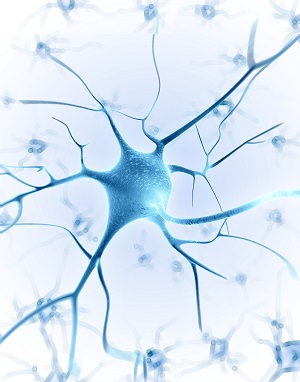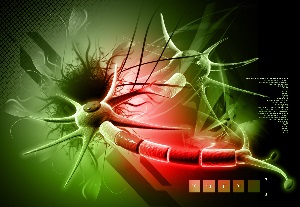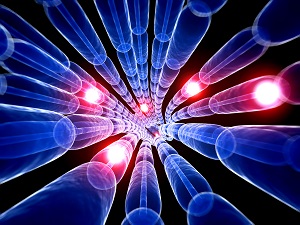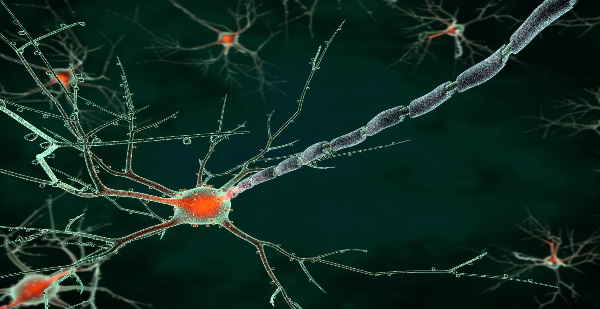31 Dec Signal Transduction in Neurons
Wires in the Brain
 Electrical impulses jump from neuron to neuron in the brain through their branching nerve fibers. This movement of electrical potentials is called signal transduction, and significantly resembles the process of electrical flow in printed circuit boards and semiconductor chips. Nerve fibers (axons and dendrites) are filled with a fluid called axoplasm. Within the axoplasm are various organelles and filaments of the three types described in prior posts. Besides providing the structural support necessary to maintain axons and dendrites, cytoskeletal components provide locomotion and pathways for essential organelles, such as synaptic vesicles, to commute the distance between the cell body and the axon termini. The extension of nerve appendages into various parts of the central nervous system and the body is what gives the brain its unique capabilities.
Electrical impulses jump from neuron to neuron in the brain through their branching nerve fibers. This movement of electrical potentials is called signal transduction, and significantly resembles the process of electrical flow in printed circuit boards and semiconductor chips. Nerve fibers (axons and dendrites) are filled with a fluid called axoplasm. Within the axoplasm are various organelles and filaments of the three types described in prior posts. Besides providing the structural support necessary to maintain axons and dendrites, cytoskeletal components provide locomotion and pathways for essential organelles, such as synaptic vesicles, to commute the distance between the cell body and the axon termini. The extension of nerve appendages into various parts of the central nervous system and the body is what gives the brain its unique capabilities.
The essential junction link in this physiology is an infinitesimally small gap, across which the sparks jump, called the synapse. The branches leading to these junctions are formed and stabilized by the cytoskeleton. I discuss details about the structural Cytoskeletal Filaments (Actin Filaments, Intermediate Filaments and Microtubules) in other posts. It is not known whether the membrane, cytoplasm, or components in the cytoplasm, such as the cytoskeleton, provide the primary path for action potential flow. Many have presumed the membrane provides this function. The mechanisms of signal transduction in neurons may be important to the way we design mechanical models of the brain.
| Understanding Context Cross-Reference |
|---|
| Click on these Links to other posts and glossary/bibliography references |
| Prior Post | Next Post |
| Aristotle and von Neumann | Axon and Dendrite Growth |
| Definitions | References |
| action potential impulse | Nature: Nodes of Ranvier |
| axons dendrites | Membranes and Potentials EKU |
| neural network ANS | Willamette on ANS models |
Myelin Sheaths
Nerve processes include dendrites and axons (nerve fibers). Output nerve fibers consist of an axon and a fatty lipoidal covering called the myelin sheath. Myelin sheaths, described earlier, are formed by glial cells that wrap around the axon during childhood and development. Interruptions in the myelin at intervals along the axon are known as nodes of Ranvier. Myelin sheaths insulate nerve fibers much the same way that other nonconductive materials are used to insulate electric wires.
– Cell Body Axon Nodes of Ranvier

The myelin sheaths on axons direct impulses. They also prevent the incidental transmission of impulses to adjacent fibers not directly connected to the axon. Conduction of action potential in unmyelinated nerve fibers is continuous; in myelinated nerves, however, impulses travel more rapidly by saltatory conduction between nodes of Ranvier. The thickness of the myelin sheath and the size of the axon govern the speed of transmission. Dendrites are not myelinated, so the outer membrane of neurons and their processes are capable of transmitting electrical potential, though the conductivity and regularity are uncertain.
Speed Regulators
The thickness factor is the basis for the three classifications of nerve fibers. Type A myelinated fibers are the thickest at about 20 microns in diameter (a micron is 0.001 millimeters). Their transmission speed ranges from 16 to 400 feet (5 to 120 meters) per second. Type B fibers are about three microns in diameter. They have thinner myelin sheaths and conduct impulses at 10 to 50 feet (3 to 15 meters) per second. Type C fibers, the smallest at one micron or less in diameter, are not myelinated. Their transmission speeds range from 2 to 7 feet (.6 to 2 meters) per second.
- Type A transmits up to 400 feet per second
- Type B transmits up to 50 feet per second
- Type C transmits up to 7 feet per second
 High speed action potential transduction in axons often depends on the molecular specialization of the insulating nodes of Ranvier. Each node is organized into a few distinct domains, each with a unique set of ion channels, cell-adhesion molecules and cytoplasmic adaptor proteins. Voltage-gated Na+ channels concentrated at the nodes are separated from K+ channels clustered near where nodes of Ranvier begin and end. This is mediated by a specialized axoglial contact that is formed between the axon and the myelinating cell at these points. This local differentiation of the axons is regulated by oligodendrocytes and myelinating Schwann cells, and affects the way axodendritic and axoaxonic synapses form and operate.
High speed action potential transduction in axons often depends on the molecular specialization of the insulating nodes of Ranvier. Each node is organized into a few distinct domains, each with a unique set of ion channels, cell-adhesion molecules and cytoplasmic adaptor proteins. Voltage-gated Na+ channels concentrated at the nodes are separated from K+ channels clustered near where nodes of Ranvier begin and end. This is mediated by a specialized axoglial contact that is formed between the axon and the myelinating cell at these points. This local differentiation of the axons is regulated by oligodendrocytes and myelinating Schwann cells, and affects the way axodendritic and axoaxonic synapses form and operate.
All this differentiation implies a level of complexity greater than is implied in the design of most neural network (ANS) models. Not only is the structure more complex than suggested by ANS, but the processes of excitation and inhibition are complex as well. As I post more of my findings, I will try to show how a cybernetic system needs to exhibit an appropriate variety of connection strategies to mimic the complex structures and processes in the human brain.
| Click below to look in each Understanding Context section |
|---|









